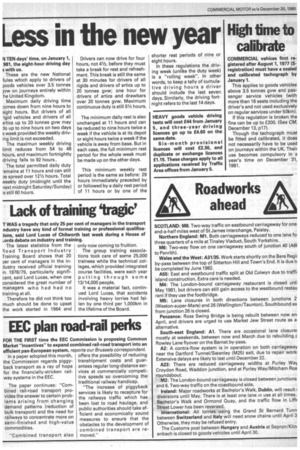Less in the new year
Page 6

If you've noticed an error in this article please click here to report it so we can fix it.
NJ TEN days' time, on January 1, 981, the eight-hour driving day s with us.
These are the new National iules which apply to drivers of pods vehicles over 3.5 tonnes )vw on journeys entirely within he United Kingdom.
Maximum daily driving time .:omes down from nine hours to aight hours. But drivers of all -igid vehicles and drivers of all artics up to 20 tonnes gvw may io up to nine hours on two days a week provided the weekly driv,ng limit is not exceeded.
The maximun weekly driving limit reduces from 54 to 48 hours, and maximum fortnightly driving falls to 92 hours.
The total permitted daily duty -emains at 11 hours and can still e spread over 12V2 hours. Total Neekly duty (midnight until the iext midnight Saturday/Sunday) still 60 hours. Drivers can now drive for four hours, not 41/2, before they must take a break for rest and refreshment. This break is still the same at 30 minutes for drivers of all rigids and drivers of artics up to 20 tonnes gvw; one hour for drivers of artics and drawbars over 20 tonnes gvw. Maximum continuous duty is still 51/2 hours.
The minimum daily rest is also unchanged at 11 hours and can be reduced to nine hours twice a week if the vehicle is at its depot or eight hours twice a week if the vehicle is away from base. But in each case, the full minimum rest period for the whole week must be made up on the other days.
This minimum weekly rest period is the same as before: 29 hours immediately preceded by or followed by a daily rest period of 11 hours or by one of the shorter rest periods of nine or eight hours.
In these regulations the driving week (unlike the duty week) is a "rolling week". In other words, to keep a tally of cumulative driving hours a driver should include the last seven days. Similarly, the driving fortnight refers to the last 14 days.




















































































